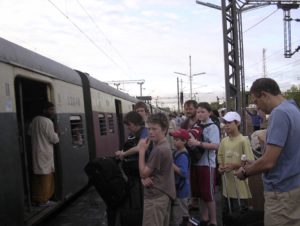Dr Douglas Randell, TMA Member in Canberra
The thought of travelling with kids may provoke anxiety for many parents, but well-planned trips are very safe. While travel immunisation is essential, kids are more likely to be injured in accidents, than they are to become sick with serious infections. It is well worth putting some time into considering risks and accident prevention prior to travel.
We all intuitively ‘child-proof’ our homes, but hazards in the hotel room don’t usually come to mind after a long trip across many time zones. It is always worth taking a moment to assess your room on arrival. Ensure electrical wall plugs are protected, hot water taps are labelled correctly and that the water is not scalding. Check that balcony railings are secure and show the kids how to get to the fire stairs. Remember kids are better at locking than unlocking, so check that the bathroom cannot be locked from the inside.
Keep medicines away from children, perhaps locked in a suitcase. Malaria tablets, in particular, can be very toxic even with quite small overdoses.
International cities are frequently more crowded than Australian cities. Streets are frequently bustling, with people and vehicles jostling for passage. Kids can easily lose sight of you in a crowd. A child who has lost sight of you is likely to look around, panic, and bolt in the direction that they are facing. This not only increases the difficulty of finding
International cities are frequently more crowded than Australian cities. Streets are frequently bustling, with people and vehicles jostling for passage. Kids can easily lose sight of you in a crowd. A child who has lost sight of you is likely to look around, panic, and bolt in the direction that they are facing. This not only increases the difficulty of finding them, but also increases the chance of accidental injury. Teaching your kids to “Hug a streetlamp” can help.
Local road conditions and rules can be very different in other countries. Kids will need extra assistance when out and about. Drivers may not ‘obey’ road rules, traffic may move on the “wrong” (opposite) side of the road, and there may be no pedestrian crossings. Three-wheel taxis, pedicabs or vans weave and dart through traffic and collisions are common. Most vehicles lack seat belts, and small children must be held on the lap – making them vulnerable to injury. It is safest to take a taxi, and have children sit in the back.
Safety near water is very important. There may be no life guards at pools or beaches and no life vests. Pools are not suitably fenced. Most kids who drown, do so very quickly, after wandering away from the family in parks, slipping when climbing on rocks, or when crossing streams. In the ocean, they can be knocked over by waves or misjudge depth. If you are not able to supervise your kids, ensure that a responsible adult is always allocated this responsibility and that they stay where kids can see them.
Think too about safety around animals. Kids love animals and are very curious. They are likely to meet many new animals that will delight them. However, kids may miss the signs of a stressed or distressed animal that can suddenly snap or bite. Dogs may not want to be patted. Monkeys around temples and other popular sites might be cute, but can be very aggressive. Kids can be bitten while trying to fend them off. It is best not to eat in such parks and close supervision is important.
Travelling with families creates memories that last a lifetime. With a bit of care, travel is also safe and lots of fun.


